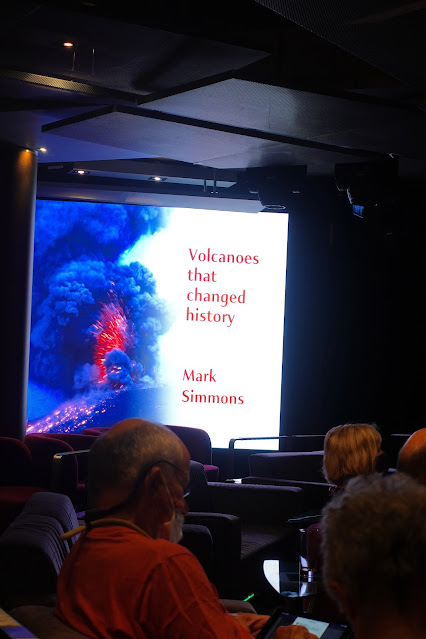We have docked at Uturoa, Raiatea, French Polynesia. Woke up to take this photo from my veranda.
So what's the big deal about the Exclusive Economic Zone? Some day, perhaps seabed mining and other ocean development rights, like the Blue Revolution, will be affected.
Conventional wisdom: US crude oil production will continue to increase for the foreseeable future, surpassing the record high of 12.44 million bpd by the end of 2023. However...
- Economy-wide cost inflation has made development and operation of oil wells more expensive;
- Many new wells are not as productive as expected;
- Drilling inventories by the shale industry are declining.
Some contrarians expect US oil production to decline by about 20% in 2023
- Did you know the U.S. exports coal? In million short tons,
- Terrestrial carbon sequestration — trees, soils, wood vaults, biochar — receives more attention than ocean sequestration, even though oceans are actually the biggest carbon sink on the planet. They store 50 times more carbon than the atmosphere and 20 times more than terrestrial plants and soils.
- There is a correlation between utility-scale wind farms and low- / negative-electricity prices.(Insert left: negative electricity price frequency in 2022.)
- In 2022, generation from renewable sources — wind, solar, hydro, biomass, and geothermal — surpassed coal-fired generation in the electric power sector for the first time; also, renewables surpassed nuclear generation for the first time in 2021 and continued to provide more electricity than nuclear generation last year. Insert: US electric power sector electricity generation, in million megawatthours. Note, of course, that natural gas remains around twice the generation source of the renewables.

- Something of historical note about light (note that this is a logarithmic scale):
Retrospective: In an award-winning 1996 paper, Nobel laureate economist Bill Nordhaus traces how the price of light has fallen throughout one million years of human history. AES Members have access to the legendary paper.
- When light came from open fires, the price of lighting was the effort it took to gather wood. Nordhaus calculates that it took 60 hours of labor to generate 1000 lumen-hours.
- The Greeks and Romans had wax candles. A typical wax candle puts out 13 lumens, and according to Nordhaus’ calculations, wax candles require 5 hours of labor to generate 1000 lumen-hours.
- Oil, gas, and kerosene lamps were developed in the 1800s, pushing the effective price of lumens down dramatically. Depending on the source of fuel, Nordhaus calculates as low as 0.2 hours of labor per 1000 lumen-hours.
- Developments in electric power, carbon-filament, and tungsten-filament enabled light bulbs to be commercialized in the 1880s and 1920s, respectively. These innovations pushed the price lower still, to 0.01 hours of labor per 1000 lumen-hours, by Nordhaus’ calculations.
- Even with little additional technological innovation in light bulbs between the 1920s and 1980s, the effective price of lighting continued to drop precipitously as wages increased and electricity prices declined.
- By the time CFLs arrived in the 1990s, Nordhaus calculates that it took only .0001 hours of labor per 1000 lumen-hours, about 600,000 times cheaper than it was for prehistoric man gathering wood for open fires.
Continuing the Energy Matters summary.
- Northern India is experiencing its hottest temperatures in the last 122 years and will reach 40°C in May and June (the hottest months of the year) and peak at 50°C. Note: it is estimated that when temperatures exceed 35°C, a human body can no longer cool itself through perspiration (aka a "wet bulb" temperature).
- On Climate and Sustainability.
The IPCC released its sixth and final assessment cycle. Summary: all countries — especially the wealthy countries that generate the most emissions — must eliminate emissions and pull more carbon from their atmosphere. Also, projections for the climate make for grim reading. (Note: AES Members have access to the 8,000 page report.) Four take-aways from the 6th IPCC assessment:
- Climate impacts are more widespread and severe (an "atlas of human suffering") than anticipated in the first assessment.
- Some climate impacts are irreversible.
- More investment in resilience is needed.
- Decarbonization and adaptation efforts must increase dramatically.
- Also from the 6th IPCC assessment: A person born in 1953 has experienced 0.85 degrees of warming in their lifetime, but someone born in 2020 will experience about three times higher warming rates by the time they are 70.
The warming climate is creating conditions in which some trees (typically hardwoods) in some regions actually have had their annual growing season extended about one month. Leaves are staying on trees about 15% longer under the same conditions (type, region, etc.).
- RMIT University researchers (principal investigator, Nasir Mahmoud) find new less expensive and more energy-efficient method to make hydrogen from seawater.
- Virtually all the hydrogen used today is produced from fossil fuels, about the same amount of carbon dioxide annually produced in the UK and Indonesia, combined.
- Basically, the RMIT team created a special catalyst to especially function with seawater.
- This development shows potential for competing with hydrogen from fossil fuels.
About 20 team members are involved in the plan, including Hawaiian Electric, Kauai Island Utility Cooperative, Puna Geothermal Venture, Hawaii Gas, the state Department of Transportation, the Hawaii Natural Energy Institute at the University of Hawaii, the National Renewable Energy Lab, Swiss-based energy firm Hitachi Zosen Inova and New York-based hydrogen development firm Enso Infrastructure.
Went to a lecture.
Dinner with Venus.
Best osso buco I've ever had in my life. The marrow quantity was massive.
Did 6007 steps yesterday. That exercise routine works.




















Comments
Post a Comment